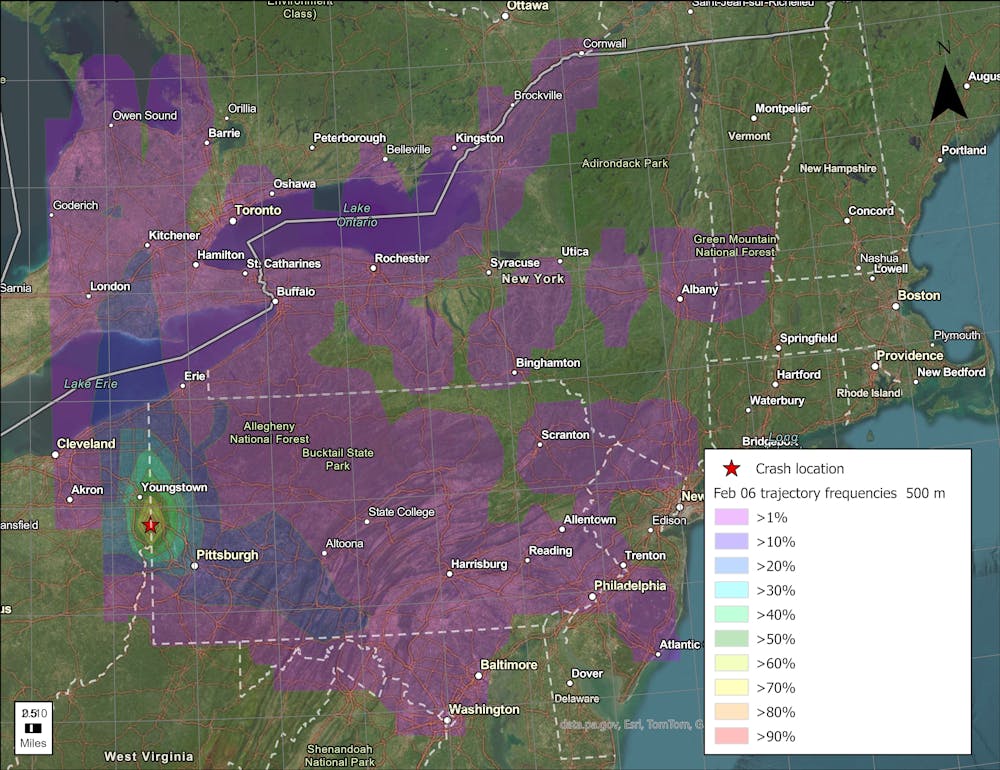Investigation Reveals Lingering Toxic Chemicals From Ohio Train Derailment

Table of Contents
The Extent of Chemical Contamination
The scale of chemical contamination resulting from the Ohio train derailment is alarming and far-reaching. Testing continues to reveal the extent of the environmental damage, posing long-term challenges for the affected communities.
Soil and Water Contamination
Soil and water sources in the vicinity of the derailment have been significantly compromised. Testing methods, including soil sampling and water analysis, have confirmed the presence of various toxic chemicals above safe limits. The long-term impact on the environment is still being assessed, with concerns extending to the potential contamination of the Ohio River and its ecosystem.
- Contaminated Areas: Testing has revealed significant contamination in the immediate vicinity of the derailment site, extending to nearby waterways and agricultural lands.
- Levels of Contamination: Reports indicate elevated levels of vinyl chloride, butyl acrylate, and other hazardous substances in both soil and water samples.
- Ongoing Monitoring Efforts: Continuous monitoring of soil and water quality is crucial to track the spread of contamination and guide remediation efforts. This includes regular testing and the implementation of advanced monitoring technologies.
Air Quality Concerns
The release of toxic chemicals into the atmosphere has also raised significant concerns about air quality in the affected areas. Residents have reported various respiratory problems, and ongoing air quality monitoring is essential to assess the long-term health risks.
- Specific Air Pollutants: Detected air pollutants include vinyl chloride, hydrogen chloride, and other volatile organic compounds (VOCs), all known to have adverse health effects.
- Health Symptoms Reported by Residents: Many residents have reported experiencing headaches, nausea, respiratory irritation, and other symptoms potentially linked to exposure to the released chemicals.
- Ongoing Air Quality Testing Data: Air quality monitoring data is continuously collected and analyzed to track pollutant levels and assess their impact on public health. This data informs public health advisories and remediation strategies.
Health Impacts on Residents
The Ohio train derailment has had a profound impact on the health and well-being of residents in the surrounding communities. The long-term health consequences of exposure to these toxic chemicals remain a serious concern.
Reported Illnesses and Symptoms
Numerous individuals living near the derailment site have reported experiencing a range of health issues, potentially linked to exposure to the released chemicals. These reports emphasize the urgent need for comprehensive medical monitoring and support.
- Specific Health Problems Reported: Reported symptoms include headaches, nausea, vomiting, respiratory problems (coughing, shortness of breath), skin irritation, and eye irritation.
- Number of Reported Cases: The exact number of individuals affected is still being determined, but reports indicate a significant number of residents seeking medical attention for symptoms potentially linked to the derailment.
- Ongoing Medical Studies: Independent medical studies are crucial to accurately assess the long-term health impacts of exposure to these chemicals. This requires comprehensive data collection and analysis.
Government Response and Support
The government's response to the health concerns of residents has been a focal point of scrutiny. Access to adequate medical care, comprehensive testing, and long-term support are critical for those affected.
- Government Initiatives to Address Health Concerns: Various government initiatives have been launched to provide medical assistance, testing, and support services to affected residents. However, the adequacy and effectiveness of these initiatives are subjects of ongoing debate.
- Availability of Medical Resources: Ensuring sufficient access to medical care, including specialized testing and treatment for chemical exposure, is critical to address the ongoing health needs of residents.
- Compensation Programs for Affected Individuals: The establishment of fair and comprehensive compensation programs for individuals suffering health consequences due to the derailment is crucial.
Ongoing Investigations and Future Actions
Several investigations are underway to determine the causes of the derailment and to implement measures to prevent future incidents. The long-term cleanup and remediation efforts will be extensive and costly.
Regulatory Scrutiny and Accountability
The derailment has prompted intense scrutiny of railway safety regulations and the accountability of involved parties. Investigations are underway to determine the contributing factors and identify potential areas for improvement.
- Ongoing Investigations: The National Transportation Safety Board (NTSB) and other agencies are conducting thorough investigations into the causes of the derailment.
- Regulatory Changes Proposed: This tragedy is prompting calls for stricter regulations and enhanced safety measures within the railway industry.
- Potential Lawsuits Against the Railway Company: Legal actions are likely to be pursued against the railway company, holding them accountable for the damages caused by the derailment.
- Safety Improvements for Railway Transportation: Implementing advanced safety technologies and stricter regulations are essential to prevent future derailments and minimize the risk of similar environmental disasters.
Long-Term Cleanup and Remediation
The long-term cleanup and remediation efforts will be complex, extensive, and costly. A comprehensive plan is needed to address the environmental contamination and restore the affected areas.
- Cleanup Strategies: Strategies for soil and water remediation, including advanced technologies and biological methods, will be needed.
- Estimated Costs: The estimated cost of cleanup and remediation will be substantial, requiring significant financial resources.
- Timeline for Cleanup: The cleanup process will likely be long and complex, extending over several years.
- Long-Term Monitoring Plan: Long-term monitoring of soil and water quality will be crucial to ensure the effectiveness of the remediation efforts.
- Environmental Restoration: Efforts must be made to restore the affected ecosystem and mitigate the long-term environmental consequences.
Conclusion
The Ohio train derailment investigation reveals a lingering and far-reaching impact on the environment and the health of residents. The presence of toxic chemicals in soil, water, and air poses significant long-term risks. This disaster underscores the critical need for improved railway safety regulations, enhanced emergency response protocols, and robust support for affected communities. Stay informed about the ongoing investigation into the Ohio train derailment and demand stricter regulations to prevent future toxic chemical spills. Learn more at [link to relevant resource].

Featured Posts
-
 The Chinese Automotive Market Case Studies Of Bmw And Porsches Experiences
Apr 22, 2025
The Chinese Automotive Market Case Studies Of Bmw And Porsches Experiences
Apr 22, 2025 -
 Coordinating Repatriation South Sudan And The Us Governments Joint Plan For Deportees
Apr 22, 2025
Coordinating Repatriation South Sudan And The Us Governments Joint Plan For Deportees
Apr 22, 2025 -
 Legal Battle E Bay Section 230 And The Sale Of Banned Chemicals
Apr 22, 2025
Legal Battle E Bay Section 230 And The Sale Of Banned Chemicals
Apr 22, 2025 -
 Blue Origin Scraps Rocket Launch Due To Subsystem Problem
Apr 22, 2025
Blue Origin Scraps Rocket Launch Due To Subsystem Problem
Apr 22, 2025 -
 Chinas Automotive Market A Deep Dive Into The Difficulties Faced By Premium Brands
Apr 22, 2025
Chinas Automotive Market A Deep Dive Into The Difficulties Faced By Premium Brands
Apr 22, 2025
